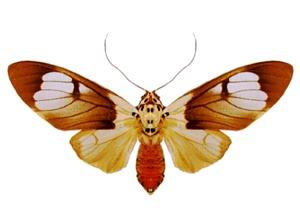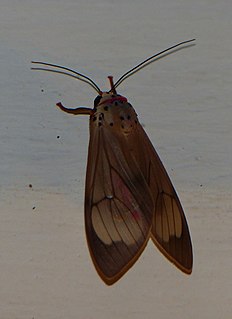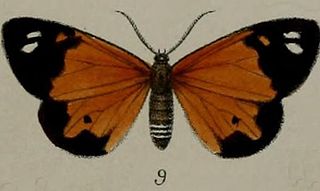Herbert Druce, FLS was an English entomologist. His collections were acquired by Frederick DuCane Godman (1834–1919), Osbert Salvin (1835–1898), and James John Joicey (1870–1932) before being bequeathed to the Natural History Museum, London. He is not to be confused with his son, the English entomologist Hamilton Herbert Druce, who also worked on Lepidoptera.

Amerila is a genus of moths in the subfamily Arctiinae. A number of species in this genus have a special defence mechanism when they are in their adult stage. When disturbed, they exude a frothy yellow fluid from glands beside the eyes, while making a sizzling noise to ward off their attacker. Similar behaviour has been observed in fertilised females of the North-American moth Utetheisa ornatrix.

Tajuria is an Indomalayan genus of butterflies in the family Lycaenidae.

Secusio is a genus of moths in the subfamily Arctiinae first described by Francis Walker in 1854.

Sergiusia is a monotypic moth genus of the family Noctuidae described by Nye in 1980. Its only species, Sergiusia pentelia, was described by Herbert Druce in 1887. It is known from Mozambique.
Max Gaede was a German engineer and entomologist of international fame who described several hundred of new species of Lepidoptera, mainly African Noctuidae.
Amerila eugenia is a moth of the subfamily Arctiinae. It was described by Johan Christian Fabricius in 1794. It is found in China, Pakistan (Karachi), central and southern India and Sri-Lanka.
Amerila fennia is a species of moth of the subfamily Arctiinae. It was described by Herbert Druce in 1887. It is found in Cameroon, the Democratic Republic of the Congo, Gabon, Ghana, Ivory Coast, Liberia, Nigeria, Senegal, Tanzania, the Gambia and Uganda.
Amerila niveivitrea is a moth of the subfamily Arctiinae. It was described by Max Bartel in 1903. It is found in Angola, Benin, Burkina Faso, Cameroon, the Democratic Republic of the Congo, Ethiopia, Ghana, Ivory Coast, Kenya, Mali, Nigeria, Tanzania, Togo and Uganda.
Amerila phaedra is a moth of the subfamily Arctiinae. It was described by Weymer in 1892. It is found in Kenya, Mozambique, Tanzania and Zimbabwe.

Amerila syntomina is a moth of the subfamily Arctiinae. It was described by Arthur Gardiner Butler in 1878. It is found in Benin, Cameroon, the Democratic Republic of the Congo, Ghana, Guinea, Ivory Coast, Nigeria, Sierra Leone and Tanzania.

Amerila vitrea is a species of moth of the subfamily Arctiinae. It was described by Carl Plötz in 1880. It is found in Angola, Benin, Burkina Faso, Cameroon, the Republic of the Congo, The Democratic Republic of the Congo, Eritrea, the Gambia, Ghana, Ivory Coast, Kenya, Liberia, Madagascar, Mozambique, Namibia, Nigeria, Rwanda, Senegal, Sierra Leone, Somalia, South Africa, Sudan, Tanzania, Uganda, Zambia and Zimbabwe.

Terina is a genus of moths in the family Geometridae erected by Francis Walker in 1854.

Stenoglene is a genus of moths in the family Eupterotidae from Africa. The genus was described by Felder in 1874.

Pitthea cunaxa is a moth of the family Geometridae first described by Herbert Druce in 1887. It is found in the Democratic Republic of the Congo.

Eulophonotus stephania is a moth in the family Cossidae first described by Herbert Druce in 1887. It is found in Malawi, Mozambique, South Africa, Zambia and Zimbabwe.










